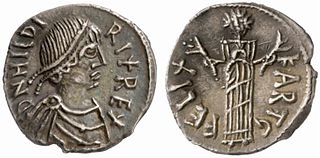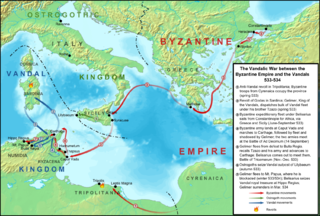Related Research Articles
The 530s decade ran from January 1, 530, to December 31, 539.

Gelimer, King of the Vandals and Alans (530–534), was the last Germanic ruler of the North African Kingdom of the Vandals. He became ruler on 15 June 530 after deposing his first cousin twice removed, Hilderic, who had angered the Vandal nobility by converting to Chalcedonian Christianity, as most of the Vandals at this time were fiercely devoted to Arian Christianity.

Hilderic was the penultimate king of the Vandals and Alans in North Africa in Late Antiquity (523–530). Although dead by the time the Vandal kingdom was overthrown in 534, he nevertheless played a key role in that event.
John the Cappadocian was a praetorian prefect of the East (532–541) in the Byzantine Empire under Emperor Justinian I. He was also a patrician and the consul ordinarius of 538.

Al-Ḥārith ibn Jabalah, was a king of the Ghassanids, pre-Islamic Arabs who lived on the eastern frontier of the Byzantine Empire. The fifth Ghassanid ruler of that name, he reigned from c. 528 to 569 and played a major role in the Roman–Persian Wars and the affairs of the Syriac Orthodox Church. For his services to Byzantium, he was made patrikios and vir gloriosissimus.

The Vandalic or Vandal War was a conflict fought in North Africa between the forces of the Eastern Roman or Byzantine Empire and the Vandalic Kingdom of Carthage, in 533–534. It was the first of Justinian I's wars of reconquest of the lost Western Roman Empire.
Sittas was a Byzantine military commander during the reign of Emperor Justinian I. During the Iberian War against the Sassanid Empire, Sittas was given command of forces in Armenia, similar to the status of Belisarius in Mesopotamia. He won a victory over the Sassanids at the battle of Satala.
Marcellus was an East Roman (Byzantine) judicial official, one of the closest aides of the Byzantine emperor Justinian I and commander of the imperial bodyguard of the excubitores in circa 541–552.
Stotzas, also Stutias, was an East Roman (Byzantine) soldier and leader of a military rebellion in the Praetorian prefecture of Africa in the 530s. Stotzas attempted to establish Africa as a separate state and had been chosen by the rebelling soldiers as their leader. Nearly succeeding in taking Carthage, Stotzas was defeated by Belisarius and fled into Numidia, where he regrouped. After another attempt at taking control of Africa, Stotzas was defeated by Germanus in 537 and fled with some of his followers into Mauretania.
Marcellus was an East Roman (Byzantine) general during the early reign of Emperor Justinian I.
Boraides was a cousin of the Byzantine emperor Justinian I, better known for his role in ending the Nika riots of 532. The primary source about him is Procopius.
Acacius was a Byzantine proconsul of Armenia Prima, c. 536–539 in the reign of Justinian I. The main source about him is Procopius.
Calonymus of Alexandria was a Byzantine naval commander, known for leading the fleet in the Vandalic War (533–534). The main source about him is Procopius.
Chilbudius or Chilbuldius was a Byzantine general, holding the rank of magister militum per Thracias in the early 530s. He was apparently killed in battle c. 533, but an impostor claimed his identity c. 545-546. The only source for both men is Procopius.
Adolius was a Byzantine silentiarius and military officer, active in the reign of Justinian I. He was a son of Acacius, proconsul of Armenia Prima. He is better known for his activities in the early stages of the Lazic War. The main source about him is Procopius.
Alexander, known by the title comes, was a Byzantine diplomat. He was active in the reign of Justinian I. The main sources about him are Procopius, John Malalas and Theophanes the Confessor.
Aratius was an Armenian military commander of the 6th century whose brother was Nerses. He served at first the Sasanian Empire, then defected to the Byzantine Empire. He is primarily known for his activities in the Iberian War and the Gothic War. He was eventually killed in an ambush. Primary sources about him include Choricius of Gaza and Procopius of Caesarea.
Solomon was an East Roman (Byzantine) general from northern Mesopotamia, who distinguished himself as a commander in the Vandalic War and the reconquest of North Africa in 533–534. He spent most of the next decade in Africa as its governor general, combining the military post of magister militum with the civil position of praetorian prefect. Solomon successfully confronted the large-scale Moorish rebellion, but was forced to flee following an army mutiny in spring of 536. His second tenure in Africa began in 539 and it was marked by victories over the Moors, which led to the consolidation of the Byzantine position. A few years of prosperity followed, but were cut short by the rekindled Moorish revolt and Solomon's defeat and death at the Battle of Cillium in 544.
Athanasius was a 6th-century Byzantine official who served as envoy and praetorian prefect of Italy and Africa under Emperor Justinian I.
Antalas was a Berber tribal leader who played a major role in the wars of the Byzantine Empire against the Berber tribes in Africa. Antalas and his tribe, the Frexenses of Byzacena, initially served the Byzantines as allies, but after 544 switched sides. With the final Byzantine victory in 548, Antalas and his Christian tribe once again became Byzantine subjects. The main sources on his life are the epic poem Iohannis of Flavius Cresconius Corippus and the Histories of the Wars of Procopius of Caesarea.